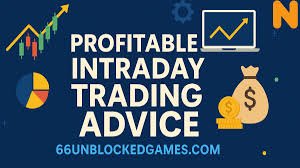Intraday trading means buying and selling assets within the same trading day. This article focuses on profitable intraday trading advice — advice that fits you, your capital, your risk tolerance, and your schedule. The goal is to share clear, practical guidance that you can apply right away. Intraday trading can be exciting because profits happen quickly, but that speed also means higher risk. The difference between losing and winning often comes down to how well you plan, how strictly you manage risk, and how consistently you follow your rules. If you want intraday trading to work for you, the advice you use must be realistic and tailored. That is what makes it “fitable.”
What “Fitable Intraday Trading Advice” Means
When we say “fitable intraday trading advice,” we mean practical tips you can actually use given your money, time, and experience. Not every tip you read will suit your situation. Some strategies need a lot of money, others need constant screen time, and some require complex tools. Fitable advice is simple to understand, clearly laid out, and possible for you to execute without overextending yourself. It is advice that helps you make consistent, manageable decisions during a trading day rather than chasing random tips or hot picks.
The Essentials: Liquidity, Volatility, and Focus
Three things matter most for intraday trading: liquidity (how easily you can buy and sell), volatility (how much price moves), and focus (how well you can watch and react). Choose assets with good liquidity so your orders fill quickly and with low slippage. Seek moderate volatility — enough movement to create profit opportunities but not so wild that you cannot manage risk. Finally, focus is essential: intraday trading requires attention and quick decisions. If you can’t follow the market for the session, intraday trading might not be a good fit.
Build a Simple, Effective Trading Plan
A good intraday trading plan makes the advice fit your life. Start by picking 1–3 assets to watch each day. For each asset, define a clear entry point — the price level where you will buy or short — and set a stop-loss so you know exactly when to exit if the market moves against you. Also define a profit target before you enter. Your plan should include position sizing: decide how much of your account you will risk on any single trade, often only 1–2% of total capital. Writing these rules down before the market opens keeps emotions out of the decision-making process.
Practical Strategies That Are Fitable
Trend-following is one of the most straightforward intraday strategies. If a stock shows a clear upward or downward trend, look for pullbacks to enter in the trend’s direction. This strategy fits many traders because it uses visible price behavior and is easy to manage with stop-losses. Another fitable approach is momentum trading: enter when strong price moves are backed by volume and exit when momentum fades. Finally, price-action and support/resistance trading use recognizable levels where price tends to react. These strategies are approachable and can be adapted to your capital and time.
Risk Management: Protect What Matters
Risk management is the backbone of fitable trading advice. Always use a stop-loss. Decide in advance how much you are willing to lose on a trade and place your stop accordingly. Keep a daily loss limit for your entire account: if you hit that limit, stop trading for the day. This prevents emotional attempts to “make back” losses and protects your capital. Also pay attention to transaction costs and taxes — these reduce net profit and must be factored into position sizing and target setting.
Position Sizing and Reward-to-Risk
Position sizing ensures you don’t make any single trade too large for your account. Use a reward-to-risk ratio to guide targets: for example, aim for at least a 1:2 reward-to-risk so that potential gains are twice the possible loss. If you follow a system where winners are bigger than losers, you can be profitable intraday trading advice even with fewer winning trades. Position size is calculated based on stop-loss distance and the percentage of your capital you’re willing to risk per trade.
Daily Routine to Make Advice Work
A consistent routine makes advice fit your day-to-day life. Before the market opens, scan the market and news. Choose the assets you’ll watch. Mark entry zones, stops, and targets on your chart. During the session, follow your plan and avoid impulsive changes. After the market closes, review your trades: what worked, what didn’t, and why. Keep a trading journal. Over time, this review and adaptation process will refine what fits you and improve your results.
Psychology: Emotion Control and Discipline
Trading psychology separates successful traders from those who struggle. Fear and greed can undo the best plan. Stick to predetermined rules: if a stop-loss is hit, accept the small loss and move on. If a target is reached, take the profit and resist the urge to squeeze more. Avoid revenge trading after a losing trade. Fitable advice includes rules for emotional control, such as limiting the number of trades per day and taking breaks when emotions are high.
Common Mistakes and How to Avoid Them
One common mistake is chasing trades after a big move. Often the best approach is to wait for a defined setup rather than jumping in late. Another error is trading illiquid stocks, which can lead to poor fills and slippage. Skipping stop-losses is another fatal habit; without a stop, losses can grow quickly. Overtrading — making too many trades to try to earn more — often leads to higher costs and worse results. A fitable approach helps you avoid these mistakes by emphasizing proper selection, clear rules, and disciplined execution.
Adapting Advice to Your Account and Schedule
Make the advice fit your account size and time availability. If you have a small account, focus on fewer trades and instruments with low minimum position sizes. If you only have limited time each day, choose strategies that require less constant monitoring, like setups that play out over a few hours. Day trading is not one-size-fits-all; adapt the tactics to match your real-life constraints.
Learning and Continuous Improvement
Intraday trading is a skill developed over time. Use a trading journal to track each trade: the setup, why you entered, where stops and targets were, and the outcome. Review patterns in your results. Learn from losing trades as well as winning ones. Adjust your plan slowly and test changes in a controlled way. Continuous improvement is part of making advice truly fitable.
Conclusion
Fitable intraday trading advice helps you trade within your means and abilities. It focuses on realistic planning, clear risk management, disciplined execution, and daily routines that build good habits. Intraday trading can be profitable intraday trading advice for those who approach it like a business: with rules, limits, and regular review. By choosing liquid assets, planning entries and exits, managing risk strictly, and controlling emotions, you create a practical path to smarter daily market moves. Over time, consistent application of fitable advice is the most reliable way to improve results and protect your capital.
REad More Articlw: axurbain.co.uk

My name is Michael Scaife, and I’ve been working for 4 years as a content analyst. I help people find out if online words or trends are fake, confusing, or just made for marketing. I look at strange or new keywords and check if they are real or just made up to get attention. My goal is to make the internet clearer, safer, and more honest for everyone. I enjoy teaching people how to spot fake ideas online and avoid being tricked by bad or misleading content.


